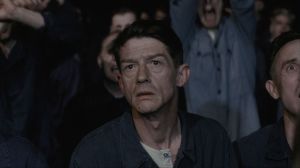
Clue: Candlestick is far from the first adaptation of a classic boardgame to comics, but it might be one of the first to achieve greatness. That has much more to do with its creator, Dash Shaw, than the source material. Much like Monopoly or Battleship, Clue offers a Rorschach test for storytelling with very little outside of a genre and some familiar elements (i.e. characters, objects, map) to suggest its narrative. That familiar set of tropes provide little more than nostalgia, it’s how Shaw interprets those elements and tells his mystery that makes Clue: Candlestick #1 stand out as an enthralling debut filled with puzzles and intrigue.
Videos by ComicBook.com
Shaw carefully layers the story, beginning with easily digestible layouts and designs every bit as clear as platonic solids. Each character is clearly themselves in the fewest lines possible, and every line on the page is designed to carefully guide the eye and convey important information. This surface makes the story a joy to read, allowing puzzles to be the only reason a reader might need to pause. The puzzles are much more complex though, both as individual hints and as parts of a sprawling, conspiratorial mystery. Each of them simply nods to the reader like an invitation within this easily read and enjoyed narrative.

A coded letter arrives early in the narrative and the essential elements are translated for readers, but the code itself and the extra sentences are all designed to be read. A dedicated reader can take an early hint to crack it and spell out each sentence themselves. That sort of attention to detail is what makes this seemingly quick read a far more engrossing experience than expected. Talk of eyelines and rules written on a map offer diversions along with new hints for the big picture. There are simply no accidents on these pages and readers will be regularly rewarded by spending more time with them.
All of the puzzles and narrative clarity are in service of a story that will be judged primarily by its ending. Nowhere in fiction is it more true that the ending is the conceit than in mysteries, and Clue: Candlestick is a consummate mystery tale. Every element, including the characters, are designed to increase complexity and pull readers into the act of solving. Even an added backstory for Colonel Mustard appears to be offering possible hints at the whys and wherefores, as well as being a very amusing twist on the man’s name. No matter how good of a first chapter Clue: Candlestick #1 might be, its success cannot be judged until the truth behind its set up is revealed.

Clue: Candlestick #1 is, more than anything else, a testament to Dash Shaw’s ability to reinterpret and explore visual information for a wide audience. It is at once utterly accessible and dastardly complex. The surface-level narrative is constructed in such as fashion as to allow any fan of mysteries or board games to enjoy, while continually offering detours for those looking to be tested. If the rest of Clue: Candlestick is as charming and challenging as its first issue, then it might be time to reassess the original game given the quality of adaptations it has continued to inspire.
Published by IDW Publishing
On May 22, 2019
Created by Dash Shaw
Cover by Dash Shaw








